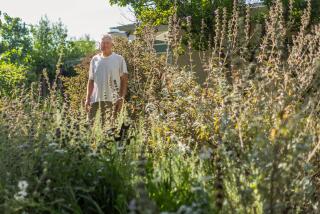Q: When is it best to...
- Share via
Q: When is it best to plant deciduous fruit trees? I also have one I’d like to move.--T.E., Burbank A: The best time for planting varies with the climate. In mild-winter areas such as Southern California, you can set out bare-root deciduous plants as soon as they are available at your local nursery. At high elevations--and in regions where winters are early and severe--spring planting is usually recommended. Moving older, more-mature deciduous trees is best accomplished during their dormancy, in the winter months, but that can be risky because even dormant trees can suffer from transplant shock. Also remember that the more of the root ball you retain, the better. In dealing with either very young or older trees, be sure to keep the roots from drying out too much during the planting process; protect them with a mulch or with wet burlap. Finally, keep in mind the old saying “Never put a $10 tree in a two-bit hole.” In other words, always make sure you prepare a planting hole substantially larger than the root ball. Q: Just before my plum tree died I noticed that it became very swollen at ground level. When I checked that particular area after I removed the tree, I found it to be soft and spongy. What happened?--R.H., Westwood A: Crown gall disease often displays the symptom that you have described around the base of an affected trunk. Because the galls initially can be confused with the natural callus that forms after a fruit tree is grafted in a nursery, the disease sometimes goes unnoticed until the tree becomes stunted and weakened. Crown gall can be chiseled off infected trees before the crown area is totally impacted, but a professional arborist should be employed for the task. An infected tree should be removed completely, with as many roots as possible taken out of the ground. A replacement tree of the same type should not be planted in that spot for three or more years. When choosing new deciduous fruit tree, reject those that show bumps or tumors near the graft union or the soil line. Q: We maintain a nice collection of healthy-looking house plants. The pots, however, seem to be infested with small black flies--much smaller than houseflies--that fly quickly out of the pots when disturbed.--A.S., El Monte
A: Those little flies are fungus gnats, which infest the soil of house plants. Although fungus gnats are a nuisance, they rarely damage the plants. Adult fungus gnats are easy to kill with common aerosol sprays. Be careful not to let large drops of spray form on the foliage, because it can burn new tender plant growth. The best way to rid plants of fungus gnats is to destroy the larvae with an insecticide drench applied to the soil surface. The gnat larvae, also very small, are transparent and live in the potting soil, feeding on decaying organic matter in the soil mix. Diazinon is quite effective against the larvae when applied regularly.
Q: Is there a way to keep our hibiscus in bloom year-round? I see them flowering in Hawaii regardless of the time of year we visit there.--S.E., Palos Verdes A: In the Southern California area, with its mild winters, hibiscus will flower all year, but it won’t ever bloom the way it does in the tropics. For the most part, hibiscus flowers come from new growth, and a healthy, vigorous plant will be more showy. Hibiscus is a heavy feeder; placing a layer of manure over the root zone in winter is an excellent way to ensure early and abundant bloom in the spring. The best time to prune is just after the heavy flowering season, which for most areas is in the early fall. Pruning in late spring may delay bloom and shorten the flowering season. Also, if the shrub doesn’t get enough water, it will show its displeasure by producing smaller flowers. All you need to do is increase the water supply, and you’ll soon see larger blooms. Q: Because of termites, I plan to have my house fumigated with methyl bromide soon. I’m worried about harming my newly planted strawberry patch that is very close to the house. What do you think?--B.B., Norwalk A: Methyl bromide and other fumigants are toxic to plants--plants damaged by fumigants usually wilt and turn brown quite rapidly--so gas from a structural pest control application should not be allowed to penetrate into their root zones. Ask your fumigator to make sure that the tarp placed over the house is laid carefully to prevent this from occurring. Before and during the fumigation, keep the soil around the plants quite wet. This helps seal the air spaces in the soil and so prevents the fumigant from seeping into the roots before the gas has dissipated. Q: We hear very little about insecticides that are derived from plants. Is that because they don’t work?--C.W., Westwood A: The problem with insecticides derived from plants--the so-called botanicals--is not that they lack effectiveness. It is more that they are not readily available. Publications such as Rodale’s Organic Gardening occasionally carry advertisements providing mail-order sources, but looking for once-common botanicals such as rotenone, nicotine and non-synthetic pyrethrum on nursery or garden-supply-store shelves is now much like shopping for a buggy whip. Many aerosols are still formulated using plant extracts. Two local formulators may help in providing retail sources for plant-derived insecticides: Chacon Chemical Corporation and Cook Laboratory Products, both located in Commerce.






